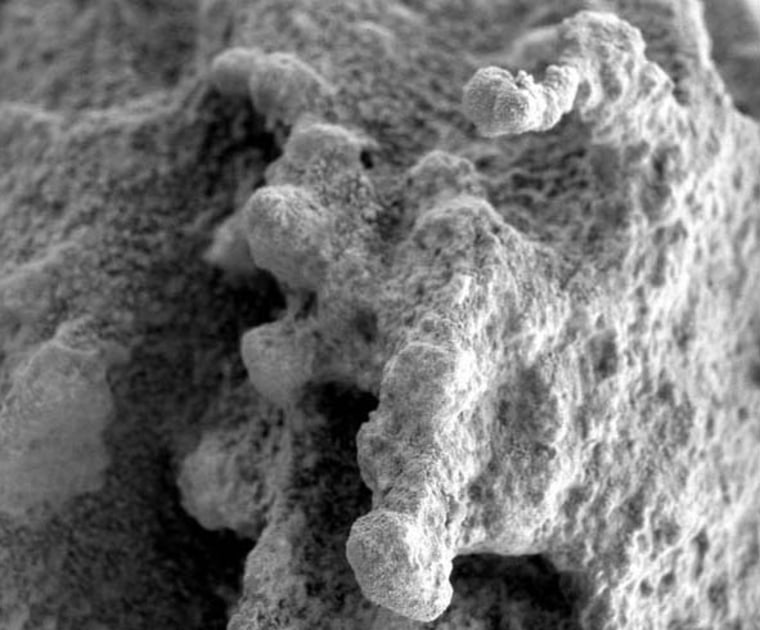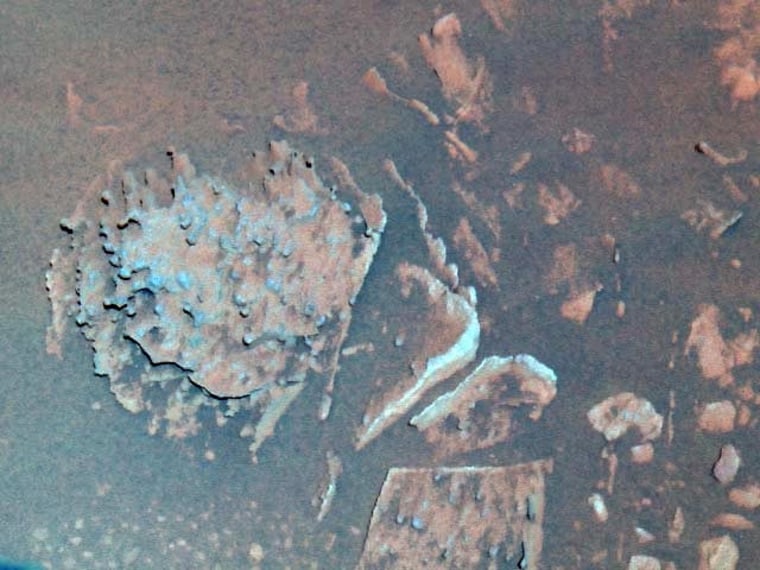NASA's Spirit rover has found a Martian rock unlike anything researchers have seen before -- on Mars or Earth -- but they hope it may finally hint at a watery past of the Gusev crater landing site. Mission engineers are also pushing the rover Opportunity to its robotic limits inside a crater on the other side of the planet.
Sitting at the foot of Gusev's "Columbia Hills," Spirit is studying "Pot of Gold," a softball-sized rock covered in knobby nuggets atop short rock stalks.
"This is a fiendishly difficult target to study," said Steve Squyres, rover principal investigator from Cornell University, during a mission briefing Friday. "I don't know how these things formed and it's driving me nuts, to be honest."
So far, the rock's most telling quality is its composition. According to Spirit's science instruments, "Pot of Gold" contains hematite, a mineral known to form in water, though it can also be produced through volcanic processes. The mineral has not been found in any other rocks at Spirit's Gusev crater landing site, but was found in quantity at Opportunity's Meridiani Planum landing site.
"The science team doesn't have a real clue as to how this hematite formed," explained Doug Ming, a rover science team member from NASA's Johnson Space Center in Houston, Texas. "Could it mean water? Yes. Could it mean something else? Yes."

Spirit has taken panoramic and microscopic images of the rock and studied with two of its robot arm-mounted spectrometers. The robot is currently preparing to bite into "Pot of Gold" with its rock abrasion tool, but the drill is typically suited for smooth rock faces, not the uneven texture of the nugget-ridden stone.
"This is a remarkably strange-looking rock, and we have not got this thing figured out yet," Squyres said, adding that so far it resembles nothing seen on Mars or Earth. "But it may be something uniquely Martian."
Mission scientists plan for Spirit to spend the next few days solely studying Pot of Gold. After that, the rover will conduct a series of maneuvers in attempts to restore its front right wheel to normal operations. The wheel has been drawing more current than its five counterparts during Spirit's trek to the Columbia Hills. Engineers hope they can stem that power drain by warming the wheel to redistribute lubricant within its drive actuator.
Opportunity on edge
On the other side of Mars at Meridiani Planum, the Opportunity rover is sitting on the cusp of the steepest slope yet on its descent inside Endurance Crater.
The slope, roughly 35 degrees downhill, is right at the mission design limits for the robotic explorer, but tests with an Earth-based rover have shown that Opportunity should be able to proceed, said Chris Voorhees, a rover mechanical systems engineer at NASA's Jet Propulsion Laboratory.
"It's very fulfilling to see us, at both landing sites, fully utilizing the capabilities of these two rovers we sent to Mars," Voorhees said during the mission briefing.
Opportunity is currently studying a series of rock layers about 16 feet (5 meters) inside the lip of Endurance, grinding into each layer with its rock abrasion tool. The layers appear very similar to those seen at Eagle Crater, Opportunity's first Mars home, where scientists were able to conclude that water did soak the region at some time in Mars' distant past.
But inside Endurance, Opportunity has made some unexpected findings.
"There's a lot more salt here than we thought," Squyres said. "And there was a lot more water involved in doing this."
As the rovers continues further inside Endurance, it no longer sees rocky ripples that indicated flowing water in the planet's past, and the level of the salt bromine appears more constant that at higher regions of crater.
One hypothesis is that these salts were deposited by evaporating water, then stirred up by Martian winds to give the crater interior its current appearance, Squyres said, adding that Opportunity should answer more questions as it moves further down into the crater.
"What I hope is to be able to learn what the total amount of water may have been," he added.
